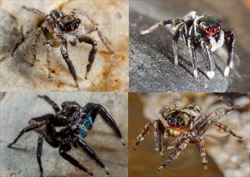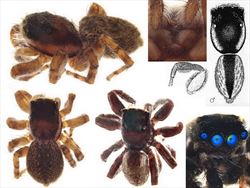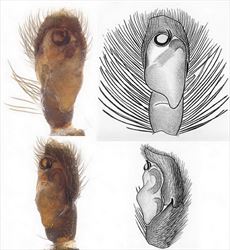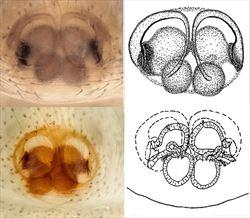
Examples of live Jotus
Illustrators (and ©) R. Whyte (BL) & I.R. Macaulay

Aspects of the general morphology of Jotus
Illustrators (and ©) B.J. Richardson (CSIRO) M. Zabka (diag,) (QMB)

Palp morphology of Jotus
Illustrators (and ©) B.J. Richardson (CSIRO), M. Żabka (diag.) (QMB)

Epigyne morphology of Jotus
Illustrators (and ©) B.J. Richardson (CSIRO), R. whyte (BL)
Jotus L. Koch, 1881
Taxonomy
Jotus has seven Australian species: Jotus auripes, J. braccatus, J. debilis, J. frosti, J. insulanus, J. minutus and J. remus. There are many undescribed species (Whyte unpubl.) Jotus is part of a distinct group of Australian genera related to the Old World genus Saitis (Zhang and Maddison 2015) including Barraina, Hypoblemum, Maratus, Prostheclina and Saratus. Further information on the genus and described species can be found in Richardson and Żabka (2017) and Whyte and Anderson (2017).
Description
Jotus spp. are small to medium-sized spiders, body length 3 to 8 mm, with a rounded, ovate to elongate-ovate abdomen. The head, viewed from above, is rectangular with the sides slightly curved, widest well behind the posterior lateral eyes. The carapace is high, rising to a peak at the posterior lateral eyes. The chelicerae have a single (unident) retromarginal tooth and two promarginal teeth. In males the first legs are longest and fringed. Jotus remus has a paddle-shaped extension of the third leg used in courtship signalling. Most males have a bright white patch of hair on the palpal patella, femur and tibia and white first tarsi.
The male’s palpal tibia has a single retro-lateral tibial apophysis with a blunt end. The tegulum is long, with a large proximal lobe. The thin, coiled embolus forms an anticlockwise circle in the distal third of the tegulum with an associated sclerite (‘conductor’).
The female has two epigynal atria with sclerotised guides. The copulatory openings are on the posterolateral edges of the atria. The insemination ducts are short and very wide, filling most of the area under the atria before joining the anterior edge of the spermathecae. The spermathecae are round, located posterior to the atria, close to the epigastric fold.
Biology
Jotus spp. are found in litter and on foliage in heathlands, woodlands and forests of eastern and western Australia ranging from coastal area with high rainfall to semi-desert and often seen around houses. The males have distinctive, often brightly coloured, ‘faces’ and palps, femurs and other leg parts. The anterior median eyes can be highly reflective, either green or blue.
Distribution
Jotus spp. have been collected in temperate regions all across Australia including Tasmania. One species is found on Lord Howe Island.
References
Hawkeswood, T.J. 2003. Spiders of Australia: An introduction to their Classification, Biology and Distribution. Sofia : Pensoft 263 pp.
Otto, J.C. & Hill, D.E. 2012. Notes on Maratus Karsch 1878 and related jumping spiders from Australia, with five new species (Araneae: Salticidae: Euophryinae). Peckhamia 103.1, 1-81.
Richardson, B.J. & Żabka, M. 2016. Salticidae. Arachnida: Araneomorphae. Canberra, Australian Faunal Directory. Australian Biological Resources Study, at https://biodiversity.org.au/afd/taxa/SALTICIDAE.
Whyte, R. & Anderson, G. 2017. A Field Guide to Spiders of Australia. CSIRO Publishing: Clayton.
* The information sheet should be interpreted in the context of the associated diagrams and photographs. Diagrams explaining anatomical terms can be found in the ‘Salticidae’ pictures at the beginning of the list of genera.